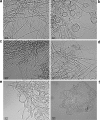Reshuffling of Aspergillus fumigatus cell wall components chitin and β-glucan under the influence of caspofungin or nikkomycin Z alone or in combination
- PMID: 22203603
- PMCID: PMC3294952
- DOI: 10.1128/AAC.05323-11
Reshuffling of Aspergillus fumigatus cell wall components chitin and β-glucan under the influence of caspofungin or nikkomycin Z alone or in combination
Abstract
Chitin and β-glucan are major cell wall components of Aspergillus spp. We investigated the antifungal activity of chitin synthesis inhibitors nikkomycin Z, polyoxin D, flufenoxuron, lufenuron, and teflubenzuron, alone and combined with the β-glucan synthesis inhibitor caspofungin. Only nikkomycin Z and caspofungin were found to act synergistically. The nikkomycin Z-induced chitin decrease corresponded with a β-glucan increase, while with the caspofungin-induced β-glucan decrease, an increase in chitin was found. This could explain the synergistic activity of this combination of drugs.
Figures


Similar articles
-
Caspofungin Treatment of Aspergillus fumigatus Results in ChsG-Dependent Upregulation of Chitin Synthesis and the Formation of Chitin-Rich Microcolonies.Antimicrob Agents Chemother. 2015 Oct;59(10):5932-41. doi: 10.1128/AAC.00862-15. Epub 2015 Jul 13. Antimicrob Agents Chemother. 2015. PMID: 26169407 Free PMC article.
-
The Paradoxical Effect of Echinocandins in Aspergillus fumigatus Relies on Recovery of the β-1,3-Glucan Synthase Fks1.Antimicrob Agents Chemother. 2017 Jan 24;61(2):e01690-16. doi: 10.1128/AAC.01690-16. Print 2017 Feb. Antimicrob Agents Chemother. 2017. PMID: 27872079 Free PMC article.
-
Differential effects of inhibiting chitin and 1,3-{beta}-D-glucan synthesis in ras and calcineurin mutants of Aspergillus fumigatus.Antimicrob Agents Chemother. 2009 Feb;53(2):476-82. doi: 10.1128/AAC.01154-08. Epub 2008 Nov 17. Antimicrob Agents Chemother. 2009. PMID: 19015336 Free PMC article.
-
Update on antifungals targeted to the cell wall: focus on beta-1,3-glucan synthase inhibitors.Expert Opin Investig Drugs. 2001 Feb;10(2):269-80. doi: 10.1517/13543784.10.2.269. Expert Opin Investig Drugs. 2001. PMID: 11178340 Review.
-
Natural products targeting the synthesis of β(1,3)-D-glucan and chitin of the fungal cell wall. Existing drugs and recent findings.Phytomedicine. 2021 Jul 15;88:153556. doi: 10.1016/j.phymed.2021.153556. Epub 2021 Mar 27. Phytomedicine. 2021. PMID: 33958276 Review.
Cited by
-
Recent advances in our understanding of the environmental, epidemiological, immunological, and clinical dimensions of coccidioidomycosis.Clin Microbiol Rev. 2013 Jul;26(3):505-25. doi: 10.1128/CMR.00005-13. Clin Microbiol Rev. 2013. PMID: 23824371 Free PMC article. Review.
-
Combinatorial strategies for combating invasive fungal infections.Virulence. 2017 Feb 17;8(2):169-185. doi: 10.1080/21505594.2016.1196300. Epub 2016 Jun 7. Virulence. 2017. PMID: 27268286 Free PMC article. Review.
-
Candida albicans Antifungal Resistance and Tolerance in Bloodstream Infections: The Triad Yeast-Host-Antifungal.Microorganisms. 2020 Jan 22;8(2):154. doi: 10.3390/microorganisms8020154. Microorganisms. 2020. PMID: 31979032 Free PMC article. Review.
-
Lung eosinophil recruitment in response to Aspergillus fumigatus is correlated with fungal cell wall composition and requires γδ T cells.Microbes Infect. 2017 Jul-Aug;19(7-8):422-431. doi: 10.1016/j.micinf.2017.05.001. Epub 2017 May 25. Microbes Infect. 2017. PMID: 28552410 Free PMC article.
-
Caspofungin Increases Fungal Chitin and Eosinophil and γδ T Cell-Dependent Pathology in Invasive Aspergillosis.J Immunol. 2017 Jul 15;199(2):624-632. doi: 10.4049/jimmunol.1700078. Epub 2017 May 31. J Immunol. 2017. PMID: 28566368 Free PMC article.
References
-
- Bonapace CR, et al. 2002. Comparison of methods of interpretation of checkerboard synergy testing. Diagn. Microbiol. Infect. Dis. 44:363–366 - PubMed
MeSH terms
Substances
LinkOut - more resources
Full Text Sources
Miscellaneous

